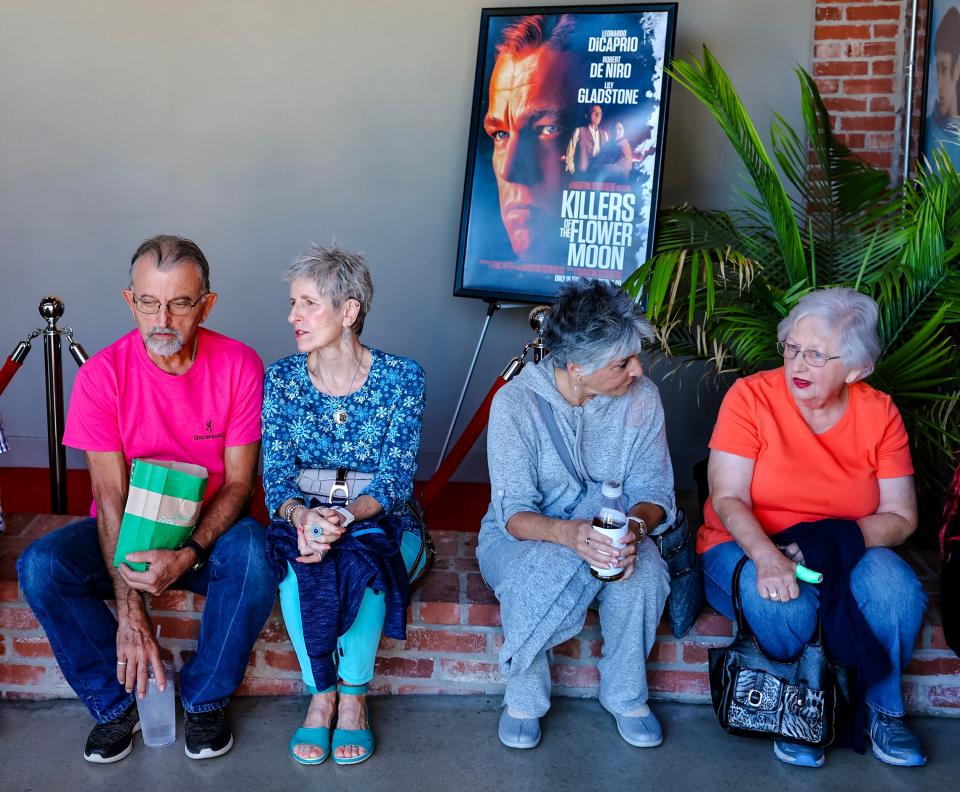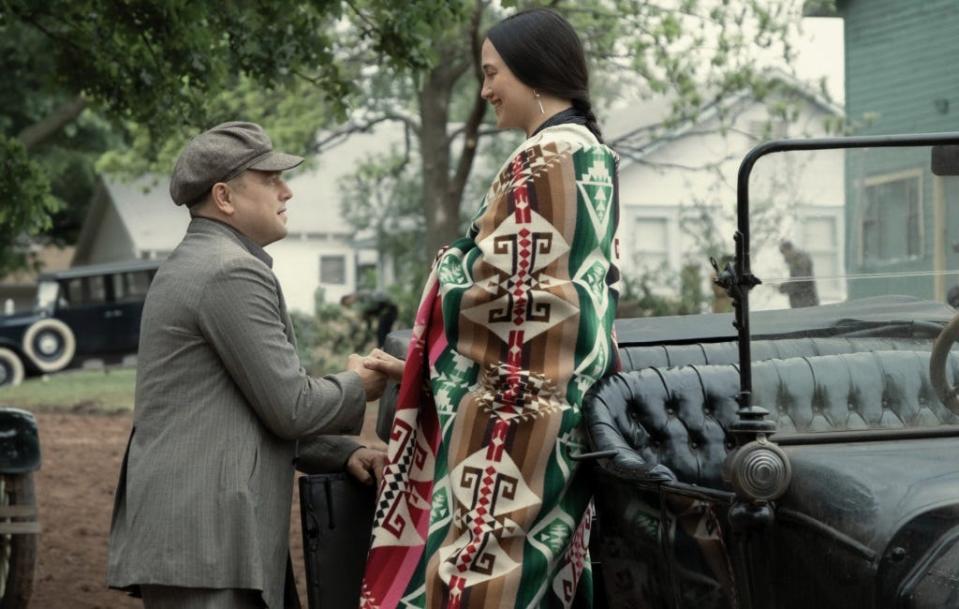Martin Scorsese's Oklahoma-made opus 'Killers of the Flower Moon' is worth the wait
Two years after Martin Scorsese filmed in and around Osage County, the time has come for "Killers of the Flower Moon" to finally be revealed to the world.
Thankfully, the movie is worth the wait.
A mesmerizing 3 1/2-hour epic, the long-awaited film is putting on big screens worldwide a dark real-life chapter of Oklahoma history: The 1920s "Reign of Terror," a series of ruthless murders of Osage Nation citizens, who had become rich through an oil boom that produced more wealth than all of the American gold rushes combined.

Starring Leonardo DiCaprio, Robert De Niro and undisputed breakout star Lily Gladstone, Scorsese's fact-based Western is adapted from David Grann's 2017 best-seller “Killers of the Flower Moon: The Osage Murders and the Birth of the FBI."
With its star-studded cast and reported $200 million budget, "Killers of the Flower Moon" is the largest movie production ever undertaken in the Sooner State.
Here's how one of cinema's most revered directors and his top-notch team, working closely with the Osage Nation, managed the enormous yet delicate task of bringing this real-life tale of racism, injustice and brutal greed to the silver screen.
More: 'Killers of the Flower Moon' premiere: Learn more about the true history, Osage people who made film
How does the movie 'Killers of the Flower Moon' differ from the book while staying true to it?
Like the first part of Grann's three-part nonfiction book, Scorsese's screenplay, which the iconic director co-wrote with fellow Oscar winner Eric Roth ("Forrest Gump"), centers on Mollie Kyle Burkhart (the phenomenal Gladstone, who is NiMíiPuu, or Nez Perce, and Siksikaitsitapi, or Blackfeet) a real-life Osage woman who lived on the tribal settlement of Gray Horse, near Fairfax.
During the Reign of Terror, Mollie and her family were marked for death in a vicious scheme to swindle away their oil money.
DiCaprio superbly portrays Mollie's treacherous husband, Ernest Burkhart, a shiftless World War I veteran who is caught between his love for his wife and the sinister plot masterminded by his charismatic uncle, William K. Hale (De Niro).
Despite the necessarily large cast, the film keeps a tight zoom on Mollie, Ernest, their family and the assorted friends and foes orbiting them. Especially with Gladstone's star-making performance to center it, this focus keeps the storytelling spellbinding — and prevents the movie from becoming an impersonal textbook rendition of the historical events.

The second and third parts of Grann's book focus on the then-fledgling FBI's investigation and the present-day implications of the Reign of Terror, respectively.
Although these sections of the bestseller are echoed in the dialogue, characterizations and, especially, in the ingenious and surprisingly emotional ending — featuring a meaningful Scorsese cameo — they are wisely left out of the main narrative. Agent Tom White (Oscar nominee Jesse Plemons) and his team of federal investigators don't even show up until two hours into the movie.
Is 'Killers of the Flower Moon' too long?
Could "Killers of the Flower Moon" be shorter? Sure, it runs three hours and 26 minutes.
But that doesn't mean it's too long.
Grann's slow-burn writing style, with its meticulous attention to detail, vivid descriptions and intriguing asides, proves well-matched with the director's epic intentions.
"Killers of the Flower Moon" isn't a popcorn movie — and it shouldn't be. It's a historical drama based on a terrible true story, and playing the long game presses viewers to take in and acknowledge the horrors instead of just glossing over them like one of the comic-book movie fictions that Scorsese has often criticized.
While the pacing could never be called snappy, the film is still captivating, plunging audiences into a time so different from our own and then compelling them to stay. The director's skill at following the most peaceful, joyous and intimate scenes with outbursts of shocking violence keeps audiences on edge and engaged.
How does 'Killers of the Flower Moon' represent the Osage Nation and Oklahoma?
From the first Instagram photo of Scorsese standing hip-deep in prairie grass while location scouting in Osage County, it's been apparent that the New Yorker is charmed by Oklahoma's natural beauty.
Thanks to the efforts of cinematographer Rodrigo Prieto and his crew, the film gorgeously showcases the grandeur and isolation of the northeastern Oklahoma frontier — it's worth the time, trouble and upcharge to see it in IMAX for the scenery alone — while the sound department complements the late Robbie Robertson's sterling score with a soundtrack of incessant winds and sweeping storms.
The close collaboration between Scorsese's team and the Osage Nation has been thoroughly documented and praised on both sides, including by Osage Principal Chief Geoffrey Standing Bear. Given Hollywood's appalling track record of misrepresenting Native Americans, it's refreshing to see "Killers of the Flower Moon" spotlight the language, culture and lifeways of the Osage people with such love, care and authenticity.
Even better, several Osage characters — especially Mollie — are depicted as smart, savvy, fully developed people with real emotions, strengths and weaknesses.
But Standing Bear in a new statement rightly calls the movie "an Osage story of trust and betrayal as directed by Martin Scorsese," and the way "Killers of the Flower Moon" is made illustrates that, while America has come a long way toward a more equal society, old power structures remain.
At the film’s premiere, Osage language consultant Christopher Cote shares his complicated feelings about #KillersOfTheFlowerMoon pic.twitter.com/DKR0KcsLTs
— The Hollywood Reporter (@THR) October 17, 2023
Although Scorsese commits to respectfully sharing the Osage’s story and focusing on Mollie's experience, he's still not able to fully tell this true-life tale from the perspective of a Native American or a woman.
The film comes closest to faltering when the story shifts away from Gladstone to its bankable white male leads, and it doesn't go far enough in exploring just what intelligent, wealthy Osage women like Mollie and her sisters are getting out their relationships with obviously shady white men.
But there's not a Native American or woman filmmaker on the planet who could muster the budget and resources that Scorsese has to bring the Reign of Terror to theaters on this kind of scope and scale — and this is the scope and scale that this story deserves. There are only a few filmmakers that get to make $200 million historical epics — and they are all white men.

Should you see 'Killers of the Flower Moon?'
Considering the intense interest that's been generated by the biggest movie ever made in Oklahoma, it's a relief to report that it's an excellent work of cinema that should stand the test of time and hopefully set a new standard for depicting Oklahoma and Native Americans on the silver screen.
With "Killers of the Flower Moon," Scorsese proves himself a master working at the top of his game and pushing everyone to rise and meet his sky-high bar. Every aspect of the production is first-rate, from the painstaking attention to period details by the production and costume departments to the stellar performances by the starry cast, which features the likes of Brendan Fraser, John Lithgow and Sturgill Simpson in small roles. (In his acting debut, Jason Isbell deserves a special mention for his supporting turn as the enigmatic Bill Smith.)
Between the lengthy runtime and the R rating for violence, grisly images and language, "Killers of the Flower Moon" isn't meant for every moviegoer.
But everyone should know the history of the Reign of Terror, and Scorsese and Co. certainly have provided a gripping way to learn it.
This article originally appeared on Oklahoman: 'Killers of the Flower Moon' review: Scorsese depicts Osage with care, quality
